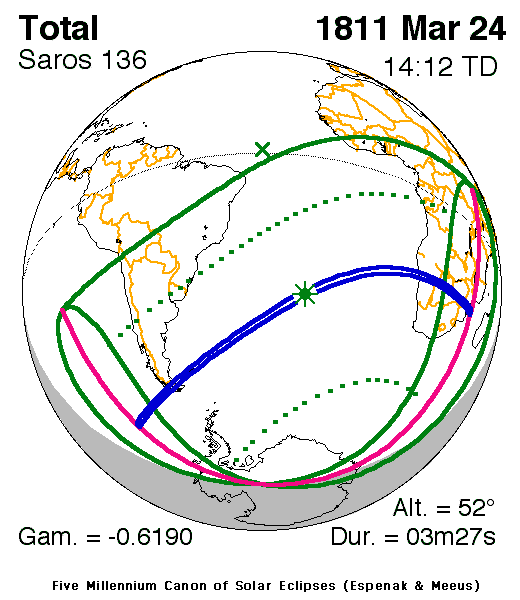A total eclipse of the Sun occurred on Sunday 24 March, 1811 UT (12 Mar, 1811 Old Style), with maximum eclipse at 14:12 UT. A dramatic total eclipse plunged the Sun into darkness for 3 minutes and 27 seconds at maximum, creating an amazing spectacle for observers in a broad path up to 176 km wide.
The total eclipse lasted for 3 minutes and 27 seconds.
Maximum eclipse was at 14:12:01 UT.
During this eclipse the Sun was 0.534° in apparent
diameter, 0.2% larger than average. The Moon was just a day past perigee, making it fairly large.
At the start and end of the eclipse the Moon
was 0.549°, and at maximum eclipse 0.557°,
which is 4.8% larger than average; hence it covered the Sun,
making this a total eclipse.
The statistics page has information on the ranges of the sizes of
the Sun and Moon, and the Moon data page displays detailed
information on the Moon's key dates.
Overview Map
This map sourced from NASA Goddard Space flight Center: GSFC Eclipse Web SiteGSFC Eclipse Web Site
The primary source of all the information on eclipses presented here at Hermit Eclipse. (NASA Goddard Space flight Center)
shows the visibility of the total solar eclipse. It also shows the broader area in which a partial eclipse was seen. (Click on it for the
full-sized version.)
Eclipse Season and Saros Series
This eclipse season contains 2 eclipses:
This was the 26th eclipse in solar Saros series 136.The surrounding eclipses in this Saros series are:
This Saros series, solar Saros series 136,
is linked to lunar Saros series 129. The
nearest partner eclipses in that series are:
Eclipse Parameters
| UT Date/time (max) | 14:12:01 on 24 Mar UT |
TDT Date/time (max) | 14:12:13 on 24 Mar TDT |
| Saros Series | 136 |
Number in Series | 26 |
| Penumbral Magnitiude | |
Central Magnitiude | 1.0416 |
| Gamma | -0.619 |
Path Width (km) | 176 |
| Delta T | 0m12s |
Error | ± 0m01s (95%) |
| Penumbral Duration | |
Partial Duration | |
| Total Duration | 3m27s |
| |
| Partial Rating | |
Total Rating | |
| Sun Distance | 149269490 km (45.0%) |
Moon Distance | 362588 km (12.3%) |
| Sun Diameter | 0.534° |
Moon Diameter | 0.549° - 0.557° |
| Perigee | 01:38 on 23 Mar UT |
Apogee | 01:58 on 4 Apr UT |
Note that while all dates and times on this site (except
where noted) are in UT, which is within a second of civil time,
the dates and times shown in NASA's eclipse listingsGSFC Eclipse Web Site
The primary source of all the information on eclipses presented here at Hermit Eclipse. (NASA Goddard Space flight Center)
are in the TDT timescale.
The Sun and Moon distances are shown in km, and as a
percentage of their minimum - maximum distances; hence 0%
is the closest possible (Earth's perihelion, or the
Moon's closest possible perigee) and 100% is
the farthest (aphelion, the farthest apogee).
The statistics page has information on the ranges of sizes
of the Sun and Moon, and the Moon data page displays detailed
information on the Moon's key dates.
Data last updated: 2015-06-21 22:11:46 UTC.

